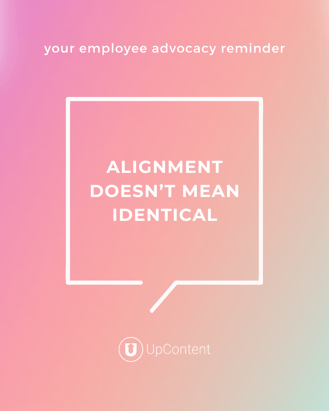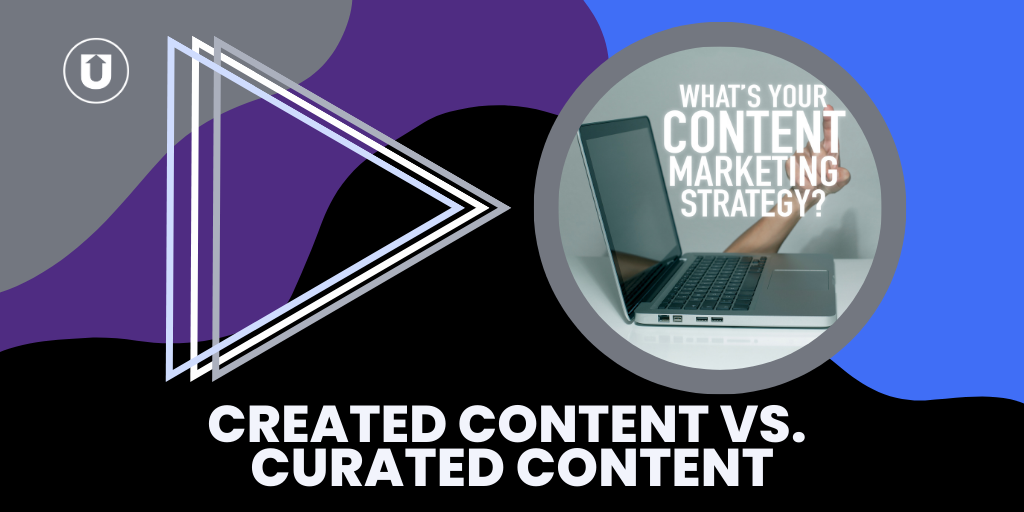How to Choose the Best Content for Successful Employee Advocacy Efforts

How do you provide the right library of external content that is valuable to your employees, meets your brand’s criteria, and positions them as credible thought leaders in their space?
When done well, employee advocacy benefits everyone involved: the employee and the brand.
But if you’re in charge of a company’s marketing and brand voice, how do you maintain the right tone and credibility without over-policing your employee’s LinkedIn profiles?
Supporting your employees in building their brands by doing the heavy lifting of recommending the articles your employees can share is a great way to prove the benefit of their participation.
But another great benefit of recommending content is mitigating the risk that an employee will share something that won’t look favorable for them or the organization.
But how do you do that in a sustainable and scalable way that continues to ensure each employee feels they can be their true selves and not simply digital copies of your branded channels?
In this article, we will define employee advocacy and how to choose the right content for your program.
Defining Employee Advocacy
A key goal of employee advocacy is to promote your brand through your employees sharing content with their audiences to make more people aware of how great the brand is.
But for your employees to do that effectively, they have to have their own level of credibility.
So, how do you ensure your team can do that?
By giving them easy access to the content they want to share - and while this most certainly includes the content your company creates, the vast majority must come from external sources.
Mixing in a healthy selection of third-party content that aligns with your employees’ professional and lifestyle interests allows them to create their own thought leadership and authentic personalities online, so their audience is more likely to listen when they share your branded content.
But should your employees be able to just share anything and everything they want?
Hardly.
In most cases, your team is looking to you to help them understand what will be most effective and what could cause internal or external compliance challenges.
Your team is often light on time, and therefore offering them a simple process and toolkit that makes all the difference in sharing what they would have wanted to share an easy habit to form.
Too much control over your employees’ channels and related messaging is easily detected by their audience and causes their profiles to be a mirror image of the brand rather than that of themselves - destroying the original point of the advocacy efforts.
So, creating a space full of third-party content that aligns with your company values, goals, AND the unique expertise of your team is a great solution and not as challenging to create as it sounds!
How To Choose The Content For Your Employees To Share
So, what content should you be picking for employees?
Wrong question. You shouldn’t be choosing exactly what your employees are sharing to build their brand online.
Instead, you should let them pick the content they want to share, but that doesn’t mean you shouldn’t create a pool of only good content that aligns with your company values and goals.
Your ability to assist in cutting through all the “noise” is often cited as a primary reason employees engage with advocacy programs over the long term.
You should set parameters for what can be shared, but you need to give them the opportunity to choose.
So, instead of your employees just picking random articles (which they probably don’t have time or willingness to put effort into), creating a collection of fresh, high-quality, credible content gives you some sense of control over what’s being shared, but your employees some control over what they share.
It’s like gentle parenting in the workplace.
Here are some of our recommendations for building the guidelines for what kind of content you want to include in the collection your team shares!
Understand Your Audience
While this seems basic and the first step to any and all marketing efforts, when considering what third-party content topics you want to include in your employee advocacy efforts, knowing who you are talking to is key.
This is going to be formulated based on your
1. Ideal client, and
2. Other things your ideal client is interested in that are adjacent to your company’s solution.
Sounds like something you likely already have completed and pretty well refined, right?
But here’s the rub. It’s not just your external audience your content library needs to be optimized for.
There is another audience that, if you don’t consider it, will prevent that external audience from ever seeing any of the content you’ve optimized.
That’s right. You also need to consider what your employees want to be sharing and how they’d like to see themselves positioned among their prospects, clients, colleagues, and friends.
Balancing what your team wants to share and what their audiences want to read is the trick.
When you give them enough optionality around a variety of topics, like industry-related articles, life-related articles, lifestyle pieces, work-life balance, stress management, etc., they will be more interested in the program because there is consistently new content they care about.
Now, you just have to make it easier for them to see that content, share it, and continue to tweak the balance of all the different categories of content you curate to match the evolving tastes of both audiences.
An example of this would be a real estate firm providing content for their realtors.
Some great third-party content to provide could center around market trends, how to prepare for buying or selling a home, and lifestyle topics such as home care, remodeling ideas, gardening, etc.
While some of these articles may overlap with your original content creation efforts, enabling your team to share a diverse set of content not only shows their own knowledge of what is being discussed outside their firm but also positions them as the resource for helping their audience determine what’s worth reading - no matter who the author is.
Align with Company Values and Brand
Many companies struggle with determining which third-party articles to allow their employees to share because they are so stringent about the content aligning perfectly with the brand voice and values.
While your company values and brand voice should be factors, they should help to shape the articles you select, but “whether your brand would have written the article the same way” should not be the criteria of whether it is worth recommending to your team.
Curated content should represent the thought leadership that your brand would like to be “friends” with. It doesn’t need to, and shouldn’t, exactly replicate what you are saying; that defeats the purpose.
Alignment doesn’t mean identical. Instead, your curated and original content should go hand in hand to create one larger picture of credibility and thought leadership.

So, instead of using the same standards for your created or branded content, use aspects of those values when building your curated content guidelines.
Some questions you can ask yourself are:
- What conversations does my team want to be a part of or prompt with their audience?
- What publishers does our team and/or our external audience tend to appreciate? How does that list vary by topic area?
- Are there areas of our own content strategy that we’ve questioned the resonance of with our external audience and where external content could help provide us the data we need to determine whether we should invest in creation on that topic?
Again, curated content should be held to a high standard in the collective sense, but each article that is recommended for your team to consider sharing won’t perfectly match up with the way your brand would have communicated the same idea - and it shouldn’t.
Loosening the grip on your third-party content will help you find more content to share and experiment with alternate ways of communicating ideas to see what is resonating - perhaps providing you some areas to build into your creation efforts as well.
Prioritize “Freshness”
One of the key benefits external content can provide is its ability to be “fresh.”
While the content your team creates can serve as assets to be used over a long timeline, external content performs best when shared near its original publication date.
For this reason, it is important to consistently add new, relevant content to the interest areas of your team while also removing older content so as not to overwhelm your employees or have them accidentally share an external article from seasons back.
Using UpContent Collections For Content Approval
These guidelines and tips sound great, but none sound super scalable if you’re doing this manually for every piece you’re finding and evaluating.
We know.
That’s where content curation software, like UpContent, comes in.
UpContent allows you to build Topics, think of them as your little search engines, and find content specific to ideas, trends, and areas of interest from UpContent’s indexed of over 250,000 publishers (and growing).
These topics can be as vague or granular as you need, even down to finding localized content if that is important to your brand.
You can then evaluate the content your Topics sourced for you and organize the content you want to use for employee advocacy into Collections, which can be made available to your team to share from within UpContent (all of our plans feature unlimited users!) or from one of our many social selling or employee advocacy integrations!
The approval process can be done manually or automatically, with this choice able to be made independently for each thematic area.
UpContent’s AI-powered automated approvals can focus on the level of relevance, the publication the article came from, the alignment between the newly published article and what historically performed well for your team, or a blend of all the above - with no manual intervention needed by your team!
UpContent can even automatically remove older content to keep your external content libraries as fresh as they are relevant.
No matter how large, your marketing team can’t go through that much content. Using a curation software like UpContent can help you cut through the digital noise so you can choose the right curated content from the best of the best.
Be Ready To Change
Remember, the first objective of any employee advocacy program should be to help your employees present themselves in the best light.
Only when they have built their own credibility can they be helpful in shining that light on the company content they share - causing their audience to stop and listen.
This means that you will need to apply a different content strategy than what you have had success with in evaluating the content your company creates.
Until you give your employees a number of high-quality articles around the topics they care about, achieving consistent interest and engagement from your team will feel nearly impossible.
Have an open feedback loop between all employees using the program where everyone involved has the option to contribute, tweak, and suggest the content their audience is interested in.
Being willing to listen, adapt, and change will help your employees be more involved in the program, and they will actually be sharing content their audiences want to learn from.
The best part of it all, you don’t have to create it!
By providing an abundance of great content, your team will build the habit of using your program as the tool for building their brand - organically eliminating their desire to find content elsewhere that may expose themselves or the company to compliance challenges.
With the proper training and guidance, those team members are going to share the things that are best to be shared.
Don’t worry about ensuring that every article is perfect.
Your employees are already subject matter experts in their industry and field; they know what they should be talking about.
Next Steps For Choosing Content For Successful Employee Advocacy Efforts
Employee advocacy isn’t just about building trust with external audiences but also about building trust with your employees so they know that what you’re offering them is worth their time to take a look at.
And that means matching their interests and what you’re encouraging them to share because they’re leaning on your expertise as a marketing, comms, or social media manager.
They need to trust that anything that shows up in the content collection should be good for them to share.
If you’re looking for a better way to provide content to your team for employee advocacy efforts, schedule a call with one of our Content Curation Experts to see if UpContent is the right curation software for your program.
Or, if you’re a DIYer, you can start a free 14-day trial with UpContent!
Here are some of our other articles on employee advocacy if you’re interested in learning more!
Stop Trying To Create Your Employees' Thought Leadership
You’re Doing Employee Advocacy Wrong If Your Employees Are Asking For This



